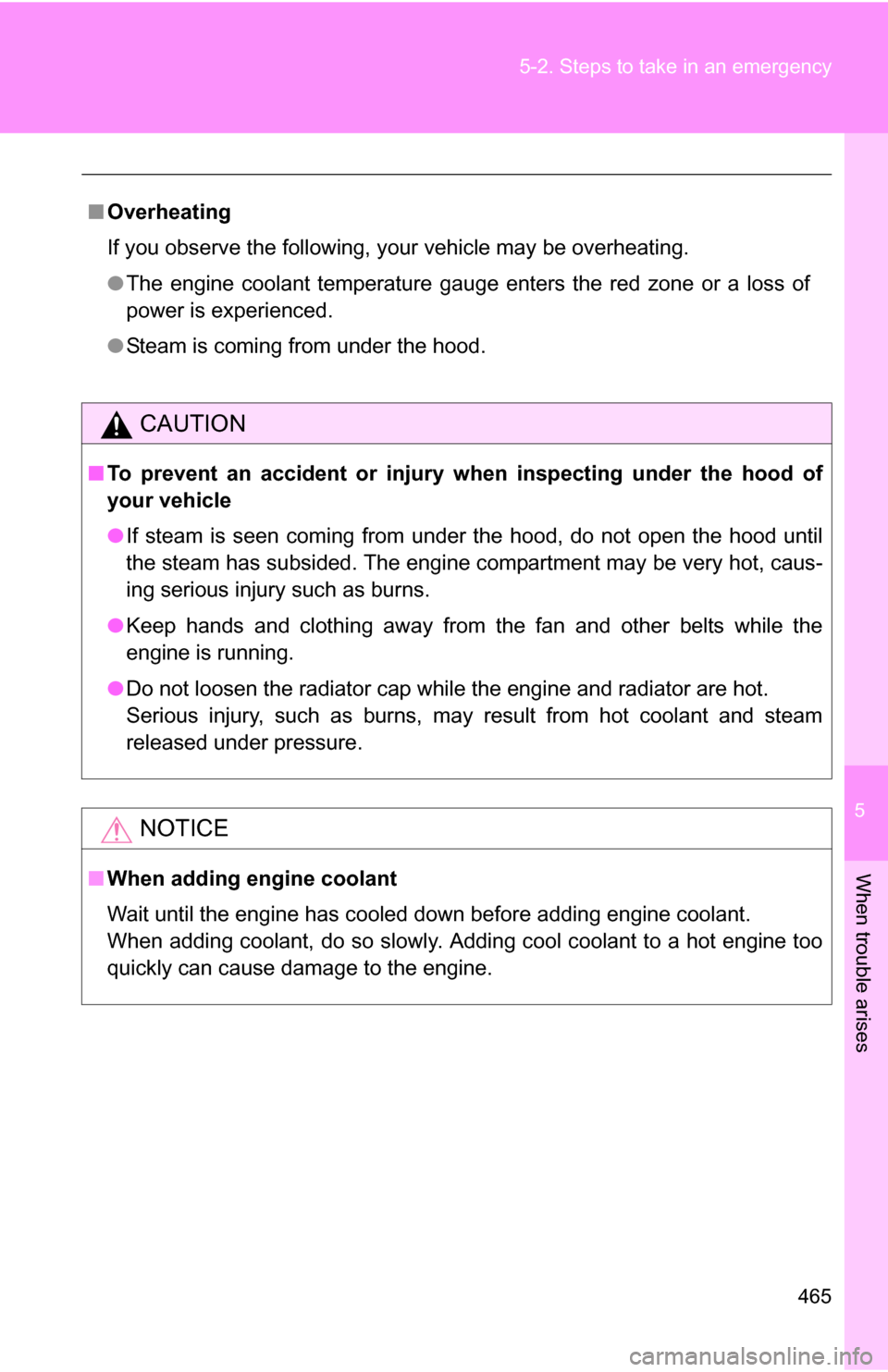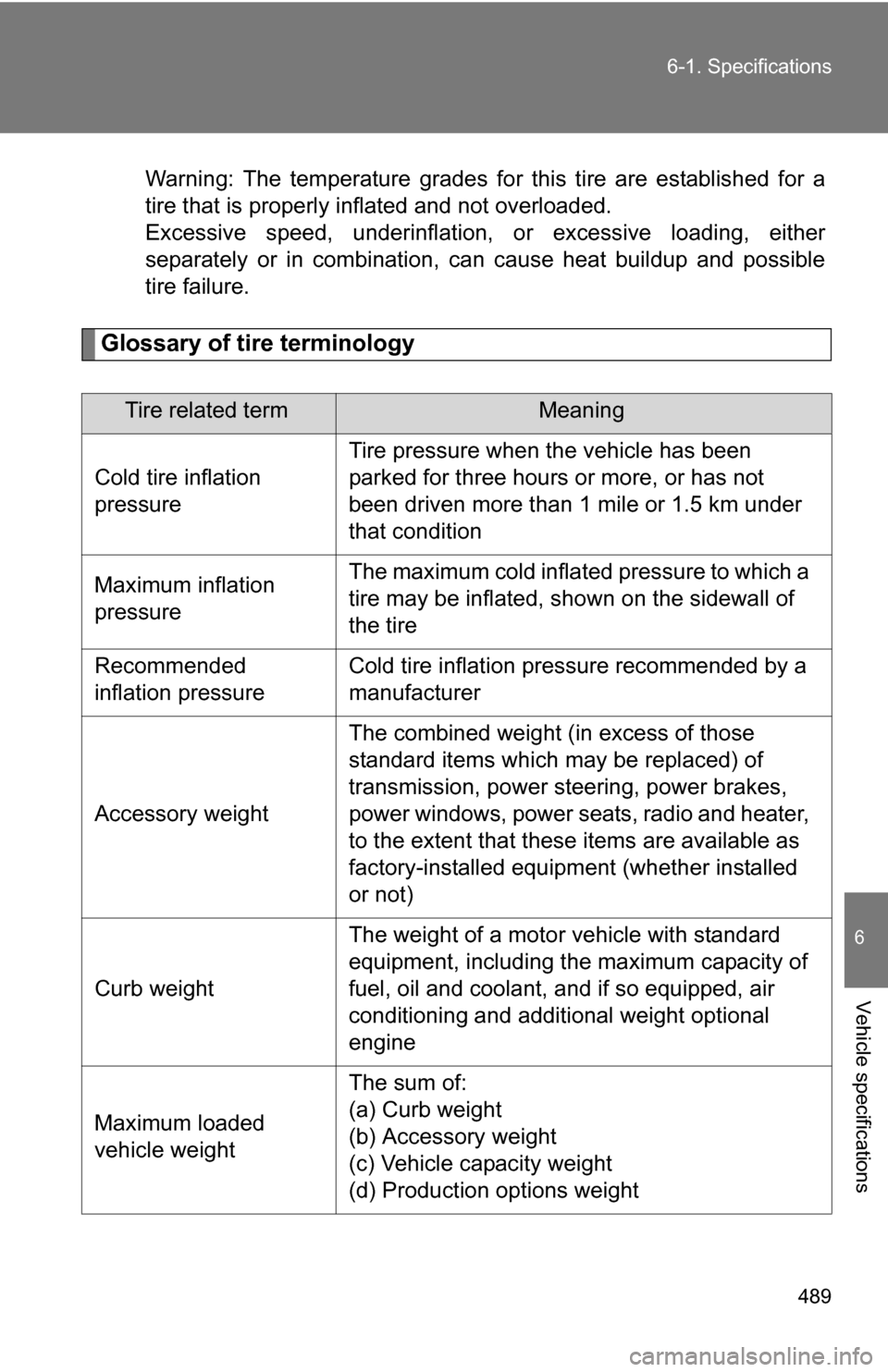Page 380 of 520

380 4-3. Do-it-yourself maintenance
Engine coolantThe coolant level is satisfactory if it is between the F (Full) and L
(Low) lines on the reservoir when the engine is cold. Reservoir cap
F
L
If the level is on or below the L
line, add coolant up to the F line.
■If the coolant level drops within a short time after replenishing
Visually check the radiator, hoses, reservoir cap, radiator cap, drain cock
and water pump.
If you cannot find a leak, have your Toyota dealer pressure test the cap and
check for leaks in the cooling system.
■ Coolant selection
Only use “Toyota Super Long Life Coolant” or similar high quality ethylene
glycol based non-silicate, non-amine, non-nitrite and non-borate coolant with
long-life hybrid organic acid technology.
U.S.A.: “Toyota Super Long Life Coolant” is a mixture of 50% coolant and
50% deionized water. (Enabled: -31 F [-35 C])
Canada: “Toyota Super Long Life Coolant” is a mixture of 55% coolant and 45% deionized water. (Enabled: -44 F [-42 C])
For more details about engine coolant, contact your Toyota dealer.
CAUTION
■ When the engine is hot
Do not remove the radiator cap.
The cooling system may be under pressure and may spray hot coolant if the
cap is removed, causing burns or other injuries.
Page 381 of 520
381
4-3. Do-it-yourself maintenance
4
Maintenance and care
Radiator and condenser
Check the radiator and condenser and clear any foreign objects.
If either of the above parts are extremely dirty or you are not sure of
their condition, have your vehicl e checked by your Toyota dealer.
Brake fluid
■ Checking fluid level
The brake fluid level should be
between the MAX and MIN lines
on the reservoir.
NOTICE
■When adding engine coolant
Coolant is neither plain water nor stra ight antifreeze. The correct mixture of
water and antifreeze must be used to provide proper lubrication, corrosion
protection and cooling. Be sure to read the antifreeze or coolant label.
■ If you spill coolant
Be sure to wash it off with water to prevent damage to parts or paint.
CAUTION
■When the engine is hot
Do not touch the radiator or condenser as they may be hot and may cause
burns.
Page 432 of 520
432
5-1. Essential information
If you think something is wrong
If you notice any of the following symptoms, your vehicle probably
needs adjustment or repair. Contact your Toyota dealer as soon as
possible.
■ Visible symptoms
●Fluid leaks under the vehicle
(Water dripping from the air cond itioning after use is normal.)
● Flat-looking tires or uneven tire wear
● Engine coolant temperature g auge needle continually points
higher than normal
■ Audible symptoms
●Changes in exhaust sound
● Excessive tire squeal when cornering
● Strange noises related to the suspension system
● Pinging or other noises related to the engine
■ Operational symptoms
●Engine missing, stumbling or running rough
● Appreciable loss of power
● Vehicle pulls heavily to one side when braking
● Vehicle pulls heavily to one side when driving on a level road
● Loss of brake effectiveness, s pongy feeling, pedal almost
touches the floor
Page 464 of 520
464 5-2. Steps to take in an emergency
The engine has cooled down sufficiently.
The engine coolant temperature gauge indicates C.
Check the engine coolant level.
Look for obvious coolant leaks from the radiator, hoses and
under the vehicle.
Note that water draining from the air conditioning is normal if it has
been used.
Add engine coolant if required.
Water can be used in an emer-
gency if engine coolant is
unavailable. ( P. 475)
Have the vehicle checked at your nearest Toyota dealer as soon as
possible.
Page 465 of 520

5
When trouble arises
465
5-2. Steps to take in an emergency
■
Overheating
If you observe the following, your vehicle may be overheating.
●The engine coolant temperature gauge enters the red zone or a loss of
power is experienced.
● Steam is coming from under the hood.
CAUTION
■To prevent an accident or injury when inspecting under the hood of
your vehicle
●If steam is seen coming from under the hood, do not open the hood until
the steam has subsided. The engine compartment may be very hot, caus-
ing serious injury such as burns.
● Keep hands and clothing away from the fan and other belts while the
engine is running.
● Do not loosen the radiator cap while the engine and radiator are hot.
Serious injury, such as burns, may result from hot coolant and steam
released under pressure.
NOTICE
■When adding engine coolant
Wait until the engine has cooled down before adding engine coolant.
When adding coolant, do so slowly. Adding cool coolant to a hot engine too
quickly can cause damage to the engine.
Page 475 of 520
475
6-1. Specifications
6
Vehicle specifications
Cooling system
Ignition system
Capacity
4.0 L V6 (1GR-FE) engine
10.4 qt. (9.8 L, 8.6 Imp.qt.)
4.7 L V8 (2UZ-FE) engine
13.0 qt. (12.3 L, 10.8 Imp. qt.)
Coolant typeUse either of the following.
• “Toyota Super Long Life Coolant”
• Similar high-quality ethylene glycol-based non-silicate, non-amine, non-nitrite, and
non-borate coolant with long-life hybrid
organic acid technology
Do not use plain water alone.
Spark plug 4.0 L V6 (1GR-FE) engine
Make
Gap
4.7 L V8 (2UZ-FE) engine
Make
Gap DENSO K20HR-U11
NGK LFR6C11
0.043 in. (1.1 mm)
DENSO SK20R11
NGK IFR6A11
0.043 in. (1.1 mm)
NOTICE
■
Iridium-tipped spark plugs
Use only iridium-tipped spark plugs. Do not adjust gap when tuning engine.
Page 489 of 520

489
6-1. Specifications
6
Vehicle specifications
Warning: The temperature grades for this tire are established for a
tire that is properly inflated and not overloaded.
Excessive speed, underinflation,
or excessive loading, either
separately or in combination, can cause heat buildup and possible
tire failure.
Glossary of tire terminology
Tire related termMeaning
Cold tire inflation
pressure
Tire pressure when the vehicle has been
parked for three hours or more, or has not
been driven more than 1 mile or 1.5 km under
that condition
Maximum inflation
pressureThe maximum cold inflated pressure to which a
tire may be inflated, s hown on the sidewall of
the tire
Recommended
inflation pressureCold tire inflation pressure recommended by a
manufacturer
Accessory weight
The combined weight (in excess of those
standard items which may be replaced) of
transmission, power steering, power brakes,
power windows, power seats, radio and heater,
to the extent that these items are available as
factory-installed equipment (whether installed
or not)
Curb weight
The weight of a motor vehicle with standard
equipment, including the maximum capacity of
fuel, oil and coolant, and if so equipped, air
conditioning and additional weight optional
engine
Maximum loaded
vehicle weight
The sum of:
(a) Curb weight
(b) Accessory weight
(c) Vehicle capacity weight
(d) Production options weight
Page 508 of 520

508 Alphabetical index
Downhill Assist Control .......... 186
Driver’s seat belt reminder buzzer ..................................... 439
Driver's seat belt reminder light ......................................... 439
Driving Break-in tips .......................... 133
Correct posture .......................93
Driving assist systems........... 188
Procedures ............................ 140
Winter driving tips.................. 213
Driving position memory...........58
DVD player ................................ 280
Electronically modulated air suspension............................. 169
Emergency, in case of If a warning buzzer sounds ................................ 436
If a warning light turns on ...... 436
If the engine will not start ...... 456
If the shift lever cannot be shifted from P...................... 457
If the vehicle battery is discharged .......................... 459
If the vehicle becomes stuck ................................... 466
If you have a flat tire ............. 445
If you lose your keys ............. 458
If you think something is wrong .................................. 432
If your vehicle needs to be towed .................................. 427
If your vehicle overheats ....... 463
Emergency flashers Switch.................................... 426
Engine
Compartment ........................ 373
Engine switch ........................ 140
Hood...................................... 372
How to start the engine ......... 140
Identification number ............. 472
If the engine will not start ...... 456 Ignition switch ....................... 140
Immobilizer system ................. 88
Overheating .......................... 463
Engine coolant Capacity ................................ 475
Checking ............................... 380
Preparing and checking before winter ....................... 213
Temperature gauge .............. 148
Engine coolan t temperature
gauge ...................................... 148
Engine immobilizer system ...... 88
Engine oil Capacity ................................ 474
Checking ............................... 375
Preparing and checking before winter .................................. 213
Warning light ................. 437, 439
Engine oil maintenance data ......................................... 378
Engine switch........................... 140
Event data recorder ................. 434
Floor mat .................................. 337
Fluid Brake..................................... 381
Washer.................................. 387
Fog lights
Replacing light bulbs ............. 417
Switch ................................... 162
Wattage................................. 480
Four-wheel drive system Four-wheel drive control switch.................................. 177
Front passenger occupant classification system ............ 108
Front passenger's seat belt
reminder light ........................ 439
Front passenger’s seat belt warning buzzer ...................... 439
Front seats Adjustment .............................. 41
E
F